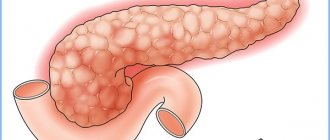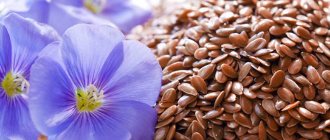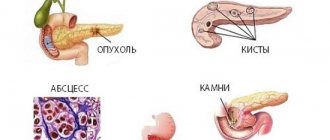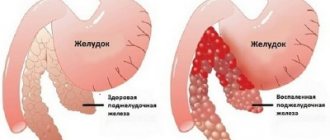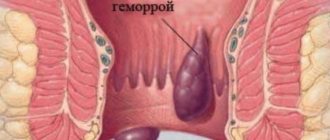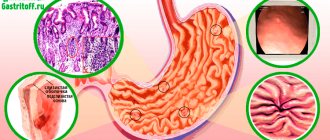Chronic pancreatitis with exocrine insufficiency develops with a long-term inflammatory process in the pancreas (over 10 years). As a result of the replacement of parenchyma with connective tissue, the organ loses the ability to fully perform endocrine and exocrine functions.
The disease is very serious because it leads to partial or complete loss of the pancreas.
The main symptoms of the pathology are dyspeptic disorders, abdominal pain, attacks of nausea, pale skin, tachycardia, shortness of breath, decreased ability to work and constant fatigue.
The main sign of pancreatic inflammation and dysfunction is the presence of undigested food particles and fat in the stool. The basis of diagnosis is the examination of stool. The components of effective therapy are special nutrition, the use of enzymatic agents and proton pump blockers.
Varieties
Subspecies by morphology
Chronic parenchymal pancreatitis is divided into three morphological forms. They differ in pathological course and clinical pictures:
- Edema is characterized by an increase in the size of the pancreas due to the accumulation of excess fluid in its tissues. It develops more often with errors in diet, especially in combination with alcohol. Sometimes it acts as a consequence as a complication of certain gastrointestinal diseases (ulcers and others). Has a bright clinic against the background of severe intoxication. Pancreatic shock does not occur in most cases. This parenchymal form does not require surgical intervention and has a favorable prognosis.
- Sclerosing is an autonomous chronic disease that arises as a result of obstruction of the glandular ducts. Or, it becomes the result of pathologies in the gastrointestinal tract. This form is characterized by the appearance of sclerotic transformations in the organ and a significant expansion of its ducts. It has striking symptoms, the main ones being pain, frequent urination, itching, glycosuria and dry mouth. Sometimes it has a latent course (5%). The sclerosing subtype is often treated conservatively and has a favorable prognosis.
- Calculous - a form aggravated by the deposition of calculi (insoluble calcium salts) in the excretory ducts. It is a dangerous subtype of parenchymal disease, since there is a high risk of complete obstruction of the pancreatic duct. It has a tendency to progression and a malignant ending, so the prognosis is not always favorable.
Subspecies with extrinsic pathology
There is another subtype of this disease - chronic parenchymal pancreatitis with exocrine insufficiency . This diagnosis is made in situations where there is a decrease in the production of certain enzymes involved in digestion. The conclusion is made on the basis of laboratory, hardware examination and specific complaints.
The immediate cause of exocrine insufficiency is the inability of the “sick” organ to cope with its responsibilities. As a result of chronic parenchymal inflammation, enzymatic “hunger” begins, which disrupts the usual process in the digestive systems. At the same time, the amount of enzyme production is sometimes reduced by quite a significant amount, equal to 70%.
Chronic parenchymal pancreatitis is a very common disease that is associated with inflammation of the pancreas. The disease proceeds in waves: remissions are replaced by stages of exacerbation, after which, even despite treatment, tissue scarring occurs. This in turn disrupts the patency of the ducts and causes changes in the functions of the pancreas, especially secretory and endocrine. The consequence of such conditions can be a disruption of insulin synthesis and the entire digestion process. As a result of a lack of vital substances, the work of other organs is disrupted, and all metabolic processes change.
To reduce the negative consequences of the disease, it is necessary to consider the clinical picture of the disease, the specifics of treatment and possible preventive measures.
Treatment
Provided that chronic parenchymal pancreatitis occurs without exacerbations, treatment of the disease is reduced to maintaining the functionality of the pancreas.
This is facilitated by drug therapy aimed at reducing and relieving pain, as well as combating inflammatory processes.
Elimination of pain and relief of the disease is achieved with the help of proton pump blockers. They reduce the amount of hydrochloric acid that is produced by the stomach and reduce the load on the pancreas. These drugs include those whose active ingredients are pantoprazole, omeprazole, lansoprazole, rabeprazole and esomeprazole.
The most common ones are:
- Nolpaza;
- Omez;
- Akrilans, Lanzap;
- Pariet;
- Nexium.
To reduce the amount of hydrochloric acid in the stomach, the use of H2-histamine blockers is no less effective. Their activity is based on the content of ranitidine and famotidine. Examples are Ranisan, Zantac and Quatemal.
Another group of medications for the treatment of chronic parenchymal pancreatitis are antispasmodics. Pain relief is achieved by reducing the pressure inside the ductal glands. Drotaverine, included in No-shpu and Spazmol, as well as mebeverine in Duspatalin, significantly alleviate the patient’s condition.
The use of nonsteroidal anti-inflammatory drugs (NSAIDs) helps slow down the inflammatory processes occurring in the pancreas. They are represented by Diclofenac, Voltaren and Ortofen.
Replacement therapy restores the balance of enzymes disturbed due to abnormal digestion of food. Lipase, amylase, trypsin and chymotrypsin are introduced into the body forcibly. Particular attention is paid to the exact dosage and correct administration of drugs. Medicines are supplied with a special coating that allows them to be delivered directly to the intestines and only then begin active work. It should be taken into account that they are taken immediately before meals. Examples include Mezim-Forte, Pancreatin, Creon and Panzinorm.
In addition to drug treatment of chronic parenchymal pancreatitis, traditional methods are used. They are of an auxiliary nature and are used exclusively with the knowledge of the attending physician.
When conventional treatment methods do not produce tangible results, and the inflammatory process in the pancreas continues to worsen, it is necessary to resort to surgical intervention. In this case, the most affected part of the organ is removed.
Causes and forms of the disease
The main cause of parenchymal pancreatitis is inattention to one’s health, or rather an incorrect lifestyle: unbalanced irregular diet, smoking, stress, excessive consumption of fatty, spicy and salty foods, lack of vitamins and proteins in the diet, and more. Often the disease can be a consequence of other diseases. In such cases, it usually develops against the background of acute pancreatitis, stomach ulcers, alcoholism and some intestinal diseases.
Depending on the causes, the forms of the disease will be determined. Primary pancreatitis is distinguished when the disease was caused by external factors that have nothing to do with the pancreas. And secondary - develops against the background of diseases of organs close to the gland.
The main factors that can cause the development of parenchymal pancreatitis include:
- One of the main causes of the disease is excessive alcohol consumption (alcoholism is found in 60% of patients). This is alcoholic pancreatitis.
- Dysmetabolic pancreatitis develops against the background of metabolic disorders. The disease may be a consequence of cystic fibrosis or increased fat content in the blood plasma.
- A disease that occurs due to problems with the biliary system is called biliary-dependent or biliary pancreatitis. It usually develops against the background of hepatitis, cholecystitis, biliary dystonia, and cholelithiasis.
- The cause of infectious pancreatitis is viral infections. The disease occurs when an infection enters the pancreas by contact.
- Autoimmune pancreatitis develops when the immune system begins to perceive pancreatic cells as foreign, releasing antibodies to destroy them.
- You can develop parenchymal pancreatitis as a result of long-term use of drugs that have a toxic effect on pancreatic tissue. The use of such medications must be under the supervision of the attending physician.
- Violation of the outflow of secretions into the intestines.
- Heredity.
It should also be emphasized that about 30% of cases of the disease do not have a specific cause. Then they talk about the idiopathic form of parenchymal pancreatitis.
https://youtube.com/watch?v=75tumoQL9l4
Surgical treatment of the disease
In some cases, chronic pancreatitis requires surgery. The indications are:
- pain that is not relieved with medications and diet;
- the presence of abscesses and cysts in the pancreas;
- obstruction of the bile ducts, which cannot be resolved using the endoscopic method;
- duodenal stenosis;
- fistulas in the pancreas with the development of pleural effusion or ascites;
- suspected cancer, not confirmed cytologically or histologically.
“Chronic pancreatitis, symptoms and treatment in adults” is an important medical topic that requires attention. This is an insidious disease, a progressive and irreversible process. However, treatment is still necessary. It allows you to prolong the life of sick people, relieves the unpleasant symptoms characteristic of chronic pancreatitis. For example, if you follow the recommendations on diet, abstinence from alcohol, and proper drug therapy, patients live up to 10 years. Half of those who do not seek medical help and continue to drink alcohol, smoke, and eat poorly die before this time.
Symptoms and clinical picture of the disease
Symptoms of the disease are sometimes mild, especially during remission. More pronounced signs of the disease can be observed during exacerbation. Then the symptoms will depend on the patient’s condition and concomitant pathologies.
Among the main symptoms of the acute phase of the disease are:
- Painful sensations. Girdle pain may be observed (on the left under the rib). By character - aching, by strength - not very strong. Among the features we can highlight the fact that pain usually occurs against the background of overeating, eating heavy fatty foods or after alcohol abuse.
- Dyspeptic disorder. It manifests itself through unstable stools, when the patient alternates between constipation and diarrhea. In this case, undigested food particles can be seen in the patient’s stool. Nausea and vomiting are additional symptoms of the condition.
- Loss of body weight. Due to the decrease in the production of digestive enzymes, food cannot be digested properly, which means that nutrients from food are not absorbed. This causes weight loss. Another factor in weight loss is pain after a meal, due to which the patient tries to eat less often.
- Development of diabetes mellitus. The presence of such a symptom indicates extensive damage to the pancreas tissue (more than 80%). Diabetes develops because the production of insulin is disrupted, due to which cells cannot absorb glucose themselves.
If these symptoms are not observed in a person for the first time, but occur periodically, then we can speak of a chronic form of the disease.
In chronic parenchymal pancreatitis, the clinical picture may consist of the following symptoms:
- diarrhea (defecation occurs almost immediately after eating), while the smell of feces is sharp and fetid;
- frequent vomiting that does not bring relief;
- nausea in the morning;
- sudden weight loss;
- obstructive jaundice may develop;
- hemorrhagic skin rashes;
- increased sweating and salivation.
Among the features of chronic recurrent pancreatitis are the following:
- exacerbation of the condition is observed 2–3 times a year;
- exacerbation occurs in a mild form, especially when following a strict diet;
- Complications in patients are rare.
If you have symptoms, you should see a doctor to begin treatment if necessary.
Symptoms
The chronic form of the disease involves a sluggish process, followed by acute attacks. Remission (apparent improvement of the condition), in which parenchymal pancreatitis practically does not manifest itself, is replaced by:
- Pain in the hypochondrium, most often on the left side or around the costal arches. Aching pain makes itself felt after overeating, eating fatty, spicy, salty foods. An overdose of alcohol can lead to the same consequences.
- Malabsorption. A lack of enzymes produced by the pancreas results in insufficient digestion of food. Weakness and lethargy are observed. The patient begins to lose weight.
- Dyspepsia. Appetite decreases. Stool becomes frequent. Nausea is felt, which may be accompanied by vomiting with a sour taste and smell.
- Symptoms characteristic of diabetes (feelings of thirst and hunger, dry skin, excessive sweating, etc.). The pancreas, which is the source of insulin, cannot cope with its duties, which leads to an increase in blood sugar.
Diagnosis and possible complications
The doctor will be able to diagnose pancreatitis based on symptoms after examining and interviewing the patient, but to confirm that the patient is dealing specifically with chronic parenchymal pancreatitis, it will be necessary to undergo an examination.
To carry out a diagnosis according to all the rules, you will need to undergo laboratory tests (general and biochemical blood tests, coprogram) and undergo instrumental examination (ultrasound, radiography, laparoscopy). Based on the results, it will be possible to establish an accurate diagnosis and begin treatment.
If the disease can be recognized at the initial stage and therapy can be started as early as possible, the effectiveness of treatment can be very high. If the patient has started the disease, then this is fraught with the development of various pathologies. The danger is that complications are difficult to treat and sometimes require surgery. Can also lead to death.
Advanced pancreatitis can cause the following complications:
- diabetes mellitus often develops, which is dangerous due to hypoglycemic crises;
- Various formations may occur that affect the functional tissues of the pancreas (cysts, abscesses, fistulas);
- one of the most dangerous options is malignant formations;
- gastritis, ulcers (of the stomach or duodenum), cholelithiasis, cholecystitis, chronic hepatitis and others may develop.
If the disease is not treated, the consequences for the patient can be very sad.
Possible complications
Complications of the disease in chronic form are not uncommon, and their manifestation significantly worsens the patient’s condition. They are expressed:
- the formation of cysts, fistulas, abscesses, ulcers in the upper parts of the digestive system;
- subrenal jaundice;
- subhepatic portal hypertension;
- abdominal ischemic syndrome;
- pancreatic ascites;
Infectious complications are possible. The most dangerous are diabetes mellitus and pancreatic cancer, which are difficult to diagnose. Late detection of a malignant tumor leaves virtually no chance for the patient to recover.
Complications that occur in severe form cause the need for surgical intervention.
By leading a healthy lifestyle and adhering to dietary standards, chronic parenchymal pancreatitis can be completely avoided. If this illness is nevertheless discovered, do not fall into despair. Timely access to doctors and careful implementation of their recommendations makes it possible to lead a full life.
Specifics of treatment
Since parenchymal pancreatitis is characterized by alternating exacerbation and remission, therapy during these periods will differ.
Treatment at the acute stage should be aimed at solving the following problems:
- reduce pain;
- relieve swelling of the gland;
- detoxify the body;
- replenish fluid and electrolyte composition of the blood;
- reduce enzyme activity;
- antibacterial therapy;
- symptomatic treatment;
- vitamin therapy.
During an exacerbation, the first thing doctors recommend is to relieve the pancreas as much as possible. Usually they prescribe a starvation diet (several days only on water) and cold on the stomach. Further nutrition should be very gentle: only boiled and stewed food. Drinking is allowed often, but in small portions. During remission, the diet continues to be followed, but the menu can be expanded (under the supervision of a doctor, taking into account blood and stool tests). Drug therapy is also selected by the doctor.
If the disease has become chronic, it will not be possible to be completely cured. The main thing that is necessary in this situation is to try to avoid exacerbations and prolong remission for as long as possible.
Pancreatitis is an inflammation of the pancreas, most often caused by malnutrition. It is quite common in both men and women. Based on the symptoms, there are several types of disease, one of which is parenchymal pancreatitis, also called recurrent. In our article we will talk about its causes, reveal the symptoms of the disease and how treatment occurs.
Non-drug treatment
Nutrition plays an important role in the treatment of chronic pancreatitis. In case of severe exacerbations, fasting days (1-3 or more) and abundant alkaline drinking are indicated. According to indications, parenteral or enteral (introduction of nutrients into the colon using a special tube) nutrition is prescribed. Thanks to this measure, it is possible to stop the secretion of the pancreas, intoxication decreases and the pain syndrome becomes weaker.
After normalization of the condition, sick people are transferred to oral nutrition. Meals should be frequent and divided. The daily menu consists of slimy soups, vegetable purees, and liquid pureed milk porridges. Drinks allowed are compotes, jelly, weak tea, mineral water, and rosehip decoction.
The following products are necessarily excluded:
- causing flatulence;
- containing coarse fiber;
- stimulating the production of digestive juices;
- rich in extractive substances.
With chronic pancreatitis, is it possible to eat fish and meat broths, mushroom and strong vegetable broths, canned food, smoked meats, sausages, fatty fish and meats, fried foods, raw vegetables and fruits, baked goods, confectionery, black bread? All these products are prohibited during exacerbation of the disease, so they should be abandoned. You also need to remove spices, ice cream, and alcohol from your menu.
During remissions, the diet changes slightly. People diagnosed with chronic pancreatitis of the pancreas are allowed to eat pasta, raw vegetables and fruits, soft, mild cheeses, and baked fish. Puree soups can be replaced with regular vegetarian ones (cabbage should be excluded from the ingredients). Porridges can be crumbly or thicker.
Causes of the disease
Most often, this disease occurs due to concomitant diseases such as:
- acute pancreatitis;
- stomach ulcer;
- alcoholism;
- cholecystitis;
- often it manifests itself against the background of a removed gallbladder.
Most often, pathology develops due to irregular food intake, unbalanced nutrition, and the lack of vitamins and protein leads to such consequences.
In addition, stressful situations, employment in hazardous work, and frequent infectious diseases can provoke an exacerbation.
Symptoms of the disease
Speaking about what chronic pancreatitis is, it is worth considering the signs of this disease. In the early stages, during periods of exacerbation, attacks are observed. They are characterized by pain in the epigastric region. In most cases they radiate posteriorly. Girdle pain is much less common. In people suffering from chronic pancreatitis, attacks occur due to the impact of provoking factors on the body. These include eating fatty foods, alcoholic and carbonated drinks.
The disease is also characterized by dyspeptic syndrome. Approximately 56% of sick people report nausea and vomiting. In 33% of cases, weight loss is observed, in 29% - flatulence, in 27% - loss of appetite. The disease may also cause symptoms such as general weakness, fatigue, and decreased ability to work.
Symptoms of the parenchymal form of the disease
Parenchymal pancreatitis, like any chronic disease, has stages of exacerbation and remission. Usually, during a period of calm, the patient feels completely healthy, and his illness does not progress. When remission passes, an exacerbation occurs with the following symptoms:
- aching pain, starting in the hypochondrium and moving to the back area;
- the damaged pancreas produces a minimal amount of digestive enzymes, and food is not completely digested. As a result, nausea, constipation, alternating with diarrhea develops;
- Due to the fact that nutrients are poorly digested and not absorbed, the body experiences hunger, as a result of which the person begins to lose weight. Lack of appetite also leads to weight loss. At this time, the feces acquire a greasy sheen and have undigested inclusions;
- There are cases that the pathology of the pancreas occurs simultaneously with diabetes mellitus, since it produces insulin simultaneously with digestive enzymes. Organ dysfunction leads to decreased insulin production and increased sugar in the body.
More about the disease
So, what is chronic pancreatitis? Experts use this term to designate a whole group of pancreatic diseases. All diseases are characterized by the following features:
- phase-progressive course with episodes of acute pancreatitis;
- focal, segmental or diffuse damage to the pancreatic parenchyma with subsequent replacement with connective tissue;
- changes in the duct system of the organ;
- formation of cysts, pseudocysts, stones and calcifications;
- development of endocrine and exocrine insufficiency.
The fact that there are different types of disease is evidenced by the International Statistical Classification, Tenth Revision. Chronic pancreatitis ICD-10 is divided into:
- CP of alcoholic etiology (code K86.0);
- other CP - infectious, recurring, relapsing, unspecified etiology (code K86.1).
Diagnostic methods
An experienced specialist can make a diagnosis of pancreatitis based on the patient’s symptoms. Not the first attack most likely indicates a chronic manifestation of the disease. However, to clarify the form of pancreatitis, it is necessary to undergo the following examination:
- Ultrasound of the abdominal organs can accurately determine the presence of organ deformation or enlargement. This type of disease is characterized by compaction of the organ, slightly reduced in size, and its main inflow does not undergo changes.
- With parenchymal pancreatitis, urine and blood tests indicate an increase in the amount of trypsin, lipase, and amylase.
- A blood test shows elevated sugar levels.
- Angiography by injecting a dye allows you to determine the deformation or narrowing of the pancreatic vessels.
Drug treatment
The selection of necessary medications is carried out by the attending physician based on the severity of the identified pathology. Their dosage and course of administration are prescribed taking into account the individual characteristics of the patient.
The main types of medications that are used to treat parenchymal pancreatitis:
- drugs that reduce the production of gastric juice (Omeprazole, Ezameprazole);
- antispasmodics for pain relief (“No-Shpa”, “Papaverine”);
- prokinetics that improve intestinal motility and promote the rapid passage of food bolus (Domperidone, Metoclopravid);
- replacement drugs that replenish the resulting enzyme deficiency.
Treatment of the disease
During treatment, it is necessary to consider that:
- It is impossible to cure chronic parenchymal pancreatitis;
- Complications should be avoided as they destroy pancreatic tissue;
- it is necessary to prolong the remission of the disease as long as possible;
- Self-medication is prohibited, especially at the acute stage.
Therapy for parenchymal pancreatitis should be carried out in a hospital. For the first 2 days, the patient is put on therapeutic fasting and is allowed to drink exclusively mineral water with pre-released gases. After which it is allowed to eat food, this requires diet No. 5. Severe pain is relieved by No-shpa, Analgin, Novocain.
https://youtube.com/watch?v=75tumoQL9l4
To relieve intoxication, a Glucose solution is administered; if the disease is caused by a lack of digestive enzymes, then it is recommended to take medications such as: Mezim-Forte, Pancreatin, Festal. When the pathology is accompanied by increased production of enzymes, the following drugs will help reduce their content: Gordox, Contrical, Trasylol. To restore the functioning of the pancreas, Methyluracil and Cobamamide are prescribed. To relieve inflammation, Ortofen or Diclofenac are indicated.
If conservative therapy does not lead to the expected result, then surgical intervention may be required to help relieve symptoms of purulent abscesses and blockage of the pancreatic ducts.
Differences between parenchymal chronic pancreatitis and biliary-dependent
Despite the similarity between biliary pancreatitis and the chronic form of parenchymal pancreatitis, differences still exist between them. The first refers to secondary pathologies, and its manifestation is facilitated by the presence of some serious illness. There are often cases when the disease becomes a consequence of congenital anomalies.
Biliary pancreatitis occurs as a result of bile entering the pancreatic ducts. Increased pressure causes rupture of the walls of the ducts. Once on the parenchyma, bile causes an increased secretion of the enzyme, and the gland begins to digest itself.
Diet food
After the exacerbation is relieved, diet No. 5 will help support the pancreas, allowing the consumption of the following foods:
- dried bread;
- lean meat, poultry and fish;
- omelette made from protein;
- cereal and vegetable soups;
- dairy products;
- steamed vegetables;
- sweet fruits;
- compotes, jelly.
Table No. 5 prohibits reception:
- alcohol;
- sour soups;
- fatty meat, poultry, fish;
- eggs;
- fresh baked goods;
- pickled, salted, fried foods;
- smoked meats;
- soda;
- chocolate;
- coffee, cocoa.
Dietary nutrition is based on frequent and small meals, at least 6 times a day, since in this way food does not have time to accumulate in the digestive tract and fewer enzymes are required to digest it.
Diet
Since the pancreas is directly related to digestion, diet plays a key role in chronic parenchymal pancreatitis. The amount of calories entering the body must strictly correspond to physical activity.
More frequent meals are recommended (up to 6 times a day), with preference given to “light” foods.
To speed up recovery processes, the body must receive an increased amount of protein. The daily norm for a person suffering from inflammation of the pancreas should be 130 g, of which only one third can be of plant origin. Meat included in the diet should be lean. However, it should not be subjected to frying, stewing or baking. The main method of preparation is boiling. You can include homemade low-fat cottage cheese in your diet menu. These products prevent tissue degeneration.
Milk for chronic parenchymal pancreatitis is recommended as a basis for soups, porridges and jelly. Its use in its pure form should be strictly limited.
Raw and fried eggs are excluded from the diet. Only steamed protein omelettes are allowed for consumption. Adding eggs to other dishes as a dietary supplement is not prohibited.
Proteins of plant origin can be obtained along with buckwheat, rice, semolina, pasta and oatmeal. You can only eat yesterday's bread.
Fats included in the daily diet for parenchymal chronic pancreatitis should not exceed 80 g, of which only 20% can be of plant origin. Oil should be included in other dishes and in limited quantities. Margarine, pork, beef and cooking fats are excluded.
Carbohydrates during the diet are limited to a daily allowance of 350 g.
This can be honey, sugar, jam and syrup. Steamed vegetable dishes are welcome. Fresh fruits should be ground before eating. It is recommended to drink compotes, especially those made from dried fruits.
In case of chronic parenchymal pancreatitis, it is necessary to strictly guard against overeating. The norm for the average person exposed to the disease is up to 2.5 kg (the amount of liquid drunk is also taken into account here). Meals should be divided into small portions and evenly distributed throughout the day.
Preventive measures
To prevent this disease from bothering the patient, you need to adhere to a healthy lifestyle, completely stop drinking alcohol and smoking, follow a diet, promptly treat infectious diseases and diseases of the digestive tract, avoid stress, and breathe fresh air more often.
This pathology needs prompt treatment, otherwise destruction of organ tissue may occur and serious complications may arise.
The pancreas performs external and internal secretory functions in the body. Under various influences, the organ ceases to fully perform its functions - to produce pancreatic juice and enzymes involved in metabolism.
The inflammatory process of the affected organ often develops into the form of chronic pancreatitis. With long-term and sluggish symptoms of the disease, chronic parenchymal pancreatitis often remains undiagnosed. If the chronic process is not properly treated, the disease will lead to diabetes mellitus, pancreatic cancer and other complications.
Prevention
To prevent the development of such a serious pathological disease, it is recommended to maintain a healthy lifestyle and maintain a proper diet, completely stop drinking alcohol and smoking, timely elimination of infectious pathologies, and regular exposure to fresh air.
The development of pancreatic pathology must be promptly stopped and eliminated, otherwise decomposition and death of the tissue structures of the gland may occur, which will lead to serious consequences and complications of the disease, including death.
The health of the human body is an invaluable gift of nature, which must be taken care of and protected, therefore, if any disorders occur and general well-being deteriorates, you should not delay, but simply immediately consult a doctor and receive timely help, without leading to the development of serious diseases.
Inflammation of the pancreas can be acute or chronic. In the first case, the cells are destroyed under the influence of a strong irritant (a violent feast, a toxic drug, migration of stones from the gall bladder). In this case, the part of the organ that has undergone the maximum impact suffers. Chronic parenchymal pancreatitis acts slowly, but the entire tissue is evenly affected. With this process, the gland cells are exposed to low doses of toxic substances. Let's talk more about this disease in our article.
Causes of parenchymal pancreatitis
The inflammatory process in the pancreas will be either localized - the parenchyma is damaged in a certain place, or mixed, when the entire organ suffers.
Factors leading to the development of chronic disease are considered:
- The etiology of diseases of the gastrointestinal tract is fatty, fried, spicy food at the wrong time and in large quantities, alcohol, as well as concomitant pathology of these organs.
- Long-term stress that affects the emotional background.
- Parasites in the body.
- Infectious diseases.
- Vascular diseases.
- Taking antibiotics for a long period.
- Traumatization of the abdominal area.
And also the cause of parenchymal pancreatitis is a congenital disease of the pancreas.
The development of inflammation of the parenchyma consists of increased production of pancreatic enzymes. Those, in turn, aggressively affect pancreatic tissue and lead to replacement with connective tissue. This manifests itself in scarring and further atrophy of the organ.
Morphologically, the following types of chronic parenchymal pancreatitis are distinguished:
The edematous form is characterized by the development of vivid symptoms: vomiting, which does not bring relief, acute pain in the abdominal area. A large amount of fluid in the parenchyma cells contributes to the development of intoxication of the body. The sclerosing form is manifested by pain in the abdomen, an allergic reaction in the form of skin itching and thirst.
The calculous form is accompanied by the formation of stones in the ducts, which is dangerous due to such complications as the pathology of the development of a malignant disease, as well as complete blockage of the duct.
In addition, chronic pancreatitis with exocrine insufficiency and biliary-dependent pancreatitis are distinguished.
Pancreatitis with impaired exocrine function develops due to the inability of the organ to fully function. This happens because digestive enzymes are not produced in sufficient quantities.
Chronic inflammation of the pancreas is inextricably linked with damage to the parenchyma of the organ. The biliary type of chronic pancreatitis is often caused by concomitant diseases: defects of the gallbladder and its ducts, disorders of the liver structure, spasms and pathological narrowing of the ducts. The listed factors influence the reverse reflux of bile, which leads to tissue damage. A feeling of bitterness in the mouth is a clear sign of the hepatobiliary type of chronic pancreatitis.
Etiology and pathogenesis of the disease
Inflammation of the pancreatic parenchyma occurs due to the release and activation of pancreatic enzymes - trypsin and lipase, which carry out autolysis of gland tissue, proliferation of connective tissue, scarring, which subsequently leads to sclerosis of the organ and chronic circulatory disorders. Infectious pancreatitis is characterized by penetration of the pathogen from the lumen of the duodenum, bile ducts or blood.
Predisposing factors to the development of chronic parenchymal pancreatitis are:
- inflammatory stenosis,
- spasms,
- sphincter of Oddi insufficiency,
- Vater's nipple tumor.
The inflammatory process in this pathology can be diffuse or limited, affecting only the head of the gland or its tail. Parenchymal pancreatitis is divided into the following morphological forms: edematous, sclerosing and calculous.
Symptoms of parenchymal pancreatitis
The main clinical manifestations characteristic of any type of pancreatitis: pain, dyspepsia and lack of appetite. Specific symptoms depend on the specific form of the disease and the nature of development (rapid or sluggish).
Chronic parenchymal biliary-dependent pancreatitis is manifested by acute pain in the left hypochondrium, which is paroxysmal in nature and often radiates to the right side. Vomiting, flatulence and “greasy” diarrhea develop, and the smell of feces is foul. The color of the skin also changes and acquires a yellowish tint.
If you do not consult a doctor in a timely manner, weight begins to fall due to the inability to properly digest food and dehydration of the body. An increase in blood glucose levels indicates a violation of the secretory function of the pancreas. Bitterness in the mouth symbolizes the reflux of bile into the ducts; the symptom can be constant or depend on food intake.
Distinctive features of the chronic process are:
- the pain is not sharp, but aching, paroxysmal, dependent on food intake. They intensify when the diet is violated - when eating foods that cannot be eaten with pancreatitis; when overeating; drinking alcohol;
- foul-smelling, mushy stools; vomiting, diarrhea. Loose stools alternate with constipation;
- lack of appetite, resulting in weight loss;
- skin manifestations in the form of dryness (due to lack of nutrients) and icteric tint (due to disruption of the bile ducts).
If you have such symptoms, contact a gastroenterologist and conduct additional laboratory and instrumental examination methods for the most accurate diagnosis.
Forms of pancreatitis
There are various classifications of the disease. One of them is a list of the following forms of chronic pancreatitis:
- Recurrent. It occurs in 55-60% of cases. With this form, periods of remission are replaced by exacerbations of the pathological process.
- Constant pain. This form is found much less frequently (in 20% of cases). With it, patients complain of constant pain, localized in the upper abdomen and radiating to the back.
- Pseudotumor (icteric). The incidence of this form of chronic pancreatitis is 10%. The pathological process is characterized by the development of inflammation in the head of the pancreas and compression of the common bile duct.
- Painless (latent). The form is detected in 5-6% of cases. The pain associated with the disease is mild or not felt at all. Dyspeptic disorders periodically occur due to impaired functioning of the pancreas.
- Sclerosing. With this form, pain occurs in the upper abdomen. They intensify after meals. The pain is accompanied by nausea, loose stools, and weight loss. When performing an ultrasound examination, specialists notice a decrease in size and thickening of the pancreas.
According to the Marseille-Roman classification, there are such forms of pancreatitis as calcific, obstructive, parenchymal and fibrosis. With the first of them, uneven lobular lesions of the pancreas are observed. Pseudocysts, cysts, calcifications, and stones appear in the ducts. What is chronic pancreatitis in obstructive form? With this type of disease, the internal organ is affected evenly. Stones do not form, and obstruction of the main pancreatic duct is observed. In the parenchymal form, foci of inflammation develop in the parenchyma. Calcifications are not formed, the ductal system is not affected. Fibrosis is characterized by the replacement of the parenchyma of an internal organ with connective tissue. Because of this process, exo- and endocrine insufficiency progresses.
Diagnostics
If complaints are detected, the patient is prescribed an additional examination, which includes:
- A general blood test, in which the doctor determines an increase in the concentration of erythrocyte sedimentation rate, an increased number of neutrophils and sugar. Hemoglobin levels decrease, leading to anemia, and protein levels decrease.
- Duodenal intubation will show a large number of enzymes (and bile contents in biliary pancreatitis). However, in severe forms, the concentration of enzymes, on the contrary, is reduced, which indicates the presence of atrophic processes in the gland.
Diagnosis of parenchymal pancreatitis is complemented by radiography and ultrasound to identify the deformation and size of the pancreas.
It is rational to conduct an examination for concomitant symptoms in a hospital setting under the supervision of a physician.
Subtype with exocrine insufficiency
In addition to the morphological forms of the disease, experts distinguish two subtypes. Each of them is characterized by certain pathological changes that lead to partial or complete loss of pancreatic functionality.
https://www.youtube.com/watch?v=YFJhfBMOIjc
The diagnosis of “parenchymal pancreatitis with exocrine insufficiency” is established when the synthesis of digestive enzymes decreases. As a result of damage, the organ is not able to produce the necessary enzymes in sufficient quantities. This provokes their deficiency in the body, which negatively affects the functioning of the digestive organs.
Laboratory and instrumental tests, which are confirmed by the patient’s complaints, help to identify the subtype of pathology.
The determination of elastaza-1 in the feces makes it possible to properly diagnose the extra-secretory insufficiency of the pancreas and to evaluate the results of therapy. The forms of the fermentative preparations, where the pancreatic ferments are concluded in the micro-granules, make it possible to correct the disturbances of cavity digestion.
Chronic pancreatitis (CP) is one of the important health problems. Over the past thirty years, there has been a more than twofold increase in the number of chronic and acute pancreatitis. In developed countries, CP has become noticeably “younger” - the average age since diagnosis has decreased from 50 to 39 years, the proportion of women has increased by 30%, and the proportion of alcoholic pancreatitis has increased from 40% to 75%. An increase in the incidence of pancreatic carcinoma (PC), which develops against the background of CP, is also recorded [1, 3, 5].
Chronic pancreatitis is a progressive inflammatory process of the pancreas, which leads to the gradual replacement of the organ parenchyma with connective tissue, changes in the ductal system of the pancreas with the formation of cysts and calculi, and the development of insufficiency of the exocrine and endocrine functions of the gland.
During CP, two stages can be distinguished: Stage I (usually up to 10 years) is characterized by alternating exacerbations and remissions, exacerbations are manifested by pain, dyspepsia is not expressed; at stage II (usually after 10 years), the pain syndrome subsides, and dyspeptic syndrome associated with exocrine pancreatic insufficiency comes to the fore [1, 2].
The syndrome of exocrine pancreatic insufficiency is caused by a decrease in the mass of the functioning exocrine parenchyma as a result of its atrophy, fibrosis, or a violation of the outflow of pancreatic secretions into the duodenum due to blockage of the excretory ducts of the pancreas by stones, adhesions or thick and viscous secretions, which leads to disturbances in the digestive process.
Digestion means the processing of complex substances (proteins, fats, carbohydrates) with the help of enzymes into simple ones for their subsequent absorption.
The main hydrolytic processes occur in the small intestine, where nutrients are broken down into monomers, absorbed and released into the blood and lymph. The process of processing nutrients in the small intestine takes place in three successive interconnected stages, united by AM Ugolev (1967) into the concept of a “digestive transport conveyor”: cavity digestion, membrane digestion, absorption.
- The initial stage of the digestive-transport conveyor - cavity digestion - includes the formation of chyme and hydrolysis of food components to an oligo- and monomeric state. A key role in cavity digestion is played by pancreatic enzymes.
- Pancreatic enzymes adsorbed on nutrients continue to play an active role in the next stage, which occurs in the parietal mucus layer. The final processing of nutrients occurs on the outer membrane of enterocytes with the help of intestinal hydrolases - this is membrane digestion.
- Then comes the last stage - absorption, i.e. the transfer of broken down components of nutrients from the intestinal lumen into the internal environment of the body.
The pancreas produces a secretion that contains enzymes that hydrolyze all types of nutrients: proteins, carbohydrates, fats. The list of the main pancreatic enzymes and their participation in digestion is presented in table. 1.
Enzymes that hydrolyze carbohydrates and fats (alpha-amylase, lipase) are secreted in an active state, proteolytic enzymes (trypsin, chymotrypsin, elastase, carboxypeptidase) are secreted in the form of proenzymes that are activated in the lumen of the small intestine. An important role in their activation is played by the intestinal enzyme enterokinase, which converts trypsinogen into active trypsin. Trypsin, in turn, activates other proteolytic enzymes.
During abdominal digestion, carbohydrates (starch, glycogen) are broken down by pancreatic amylase into disaccharides and a small amount of glucose. Under the action of proteolytic enzymes, low molecular weight peptides and a small amount of glucose are formed. Fats in the presence of bile are hydrolyzed by pancreatic lipase to di- and monoglycerides of fatty acids and glycerol.
The action of pancreatic enzymes decreases as they move from the duodenum (DU) to the terminal ileum. The level of decrease in the activity of individual enzymes varies. Thus, lipase most quickly loses its activity and is normally detected in the ileum only in small quantities.
Proteases, especially amylase, are more stable and retain, respectively, 30% and 45% of their activity in the terminal parts of the small intestine. The decrease in lipase activity is based on its proteolysis under the influence of proteases and, above all, chymotrypsin. An uneven decrease in enzyme activity from the proximal to the distal part of the small intestine is observed both in healthy people and, especially, in people with chronic exocrine pancreatic insufficiency. This explains the fact that impaired digestion of fat develops much earlier than that of starch or protein [1, 3, 4].
The secretion of the pancreas consists of two components - ductal (inorganic) and acinar (organic).
The ductal epithelium secretes a secretion rich in electrolytes, especially bicarbonates, in an aqueous solution. The function of this component of pancreatic secretion is to neutralize the acidic gastric contents entering the duodenum and transfer gastric digestion to intestinal digestion. The main stimulator of the secretion of the inorganic component is secretin, produced by S-cells of the mucous membrane of the duodenum in response to acidic contents coming from the stomach.
Glandulocytes of pancreatic acini synthesize and secrete hydrolytic enzymes under the influence of pancreozymin (cholecystokinin), which is synthesized by J-cells of the duodenal mucosa. The release of pancreozymin is mainly stimulated by food.
One of the early symptoms of impaired digestion of nutrients is steatorrhea. The feces become greasy, shiny, sticky. Patients with severe insufficiency of exocrine pancreatic function complain of bloating, excessive gas formation, a feeling of transfusion and rumbling in the abdomen. In more severe cases, polyfecal matter, steatorrhea, diarrhea and weight loss appear.
The most adequate method for studying exocrine pancreatic insufficiency is the determination of pancreatic elastase-1 in feces. The main advantage of determining fecal elastase-1 by the enzyme immunoassay is that elastase-1 is absolutely specific for the pancreas; elastase-1 is almost not destroyed when passing through the intestinal tract;
Normal exocrine function of the pancreas was determined when the elastase-1 value was from 200 to 500 μg in 1 g of feces and above, moderate and mild - 100-200 μg/g, severe - less than 100 μg/g [4, 6].
To compensate for disorders of cavity digestion, pancreatic enzyme preparations are widely used.
It has now been established that drugs intended for replacement therapy must have the following properties:
- high specific lipase activity;
- resistance to gastric juice;
- rapid evacuation from the stomach and mixing with chyme;
- short dissolution time of the microcapsule shell in the small intestine;
- rapid release of active enzymes in the small intestine;
- active participation in cavity digestion.
Microgranular forms of enzyme preparations meet these requirements. Pancreatin microtablets with a diameter of 1 to 2 mm, coated with an acid-resistant, enteric coating, are placed in a gelatin capsule. Dissolving in the stomach within a few minutes, the capsule releases microgranules that remain resistant to acidic gastric juice for 2 hours.
Lipase most quickly loses its activity, which is manifested by steatorrhea. Therefore, when correcting exocrine pancreatic insufficiency, they are primarily guided by the lipase content in the drug.
The size of microgranules is the most important factor determining the speed and timeliness of their evacuation from the stomach. The diameter of the microgranules should be 1.4 ± 3.0 mm to ensure their simultaneous passage with food through the pyloric sphincter. Mini tablets (2 mm in diameter, non-spherical shape) do not provide an ideal passage.
Characteristics of the main microgranulated multienzyme preparations are presented in Table. 2 and 3.
For most patients with moderate impairment of pancreatic exocrine function, taking 1–2 capsules (10,000–20,000 IU lipase) with meals is sufficient to eliminate steatorrhea. In severe forms of deficiency with severe steatorrhea, the number of capsules taken is increased to 4–5.
When prescribing enzyme preparations, it is advisable to focus on the level of elastase-1 in the feces (Table 4).
We assessed the effectiveness of the microgranulated enzyme preparation Micrazima.
50 patients with CP with exocrine pancreatic insufficiency were examined. A group of 30 patients received Micrasim 10,000 units, 2 capsules 3 times a day for 14 days, and a control group (20 patients) received Pancreatin 4 tablets 3 times a day for 14 days.
Treatment of parenchymal pancreatitis
Treatment of chronic pancreatic disease is carried out comprehensively. In case of exacerbation of the disease, it is advisable to observe in the gastroenterology department with a strict diet and medication. There is also the possibility of surgical intervention in the presence of complications. Treatment of parenchymal chronic pancreatitis in remission is carried out using folk remedies, not forgetting about proper nutrition, which has a gentle effect on the pancreas.
During the period of exacerbation, the consumption of food is excluded, except for water and weak sweet tea for the first 2-3 days. Then products that have undergone thorough heat treatment are gradually introduced: vegetables, broths, liquid cereals. Fatty meat, poultry, thick soups, dairy products, and alcohol are completely excluded to avoid worsening the patient’s condition. The list of what you can eat during remission of pancreatitis is extensive, as are the suggested recipes.
Medicines prescribed include non-steroidal anti-inflammatory drugs, antispasmodics, enzymes, antiemetics and antidiarrheals. If necessary, antibiotics and vitamins are used.
Can medicinal herbs be used for inflammation of the pancreas? It is possible, but starting from the 7th day of recovery and into the remission stage. These include chamomile, string, rose hips, immortelle, peppermint and others.
Remember that if you do not consult a doctor in a timely manner, the patient’s condition will quickly deteriorate, which will lead to the development of pancreatic necrosis of the pancreas, diabetes mellitus, organ cancer, sepsis, complete kidney dysfunction and ascites.
Treatment options
Treatment of chronic parenchymal pancreatitis can be carried out using conservative therapy during periods of exacerbation, folk remedies at the stage of stable remission and surgery, which requires emergency surgical intervention to perform resection of the affected area of the organ in case of serious complications of the disease.
Conservative treatment
During the period of exacerbation of the pathology, the patient is prescribed a 2-day fast, during which only alkaline drinking is allowed, and cold is applied to the abdominal area to ensure unloading of the affected organ. Then a strict regimen of dietary fractional nutrition is prescribed, in which a diet with table No. 5 must be followed.
To relieve attacks of pain, non-steroidal drugs are used, among which the most effective are:
Then it is necessary to compensate for the secretory insufficiency of the affected gland to normalize the processes of digestion and assimilation of food products. For this purpose, Mezim or Festal may be prescribed, 1-2 tablets with meals.
Treatment at home during remission
With the onset of stable remission, folk remedies become the optimal treatment. It is recommended to make decoctions and infusions, as well as brew teas from the following medicinal plants:
- field chamomile;
- immortelle;
- milk thistle;
- bitter wormwood;
- peppermint;
- dill inflorescences;
- sequences;
- calendula and many others. etc.
If, during treatment with folk remedies, symptoms begin to appear that worsen the patient’s general well-being, then taking folk medicines must be stopped and urgently consult a doctor.
In the first two to three days, eating any food is completely excluded. From the 4th day after the attack, it is allowed to eat unsalted food with a small amount of easily soluble carbohydrate compounds, ascorbic acid and B vitamins.
Some of the most useful products are: honey, natural fruit juices, cranberry-based fruit drink, berry decoctions and compote.
On the 8th day, it is allowed to introduce foods with vegetable and milk protein, as well as a small amount of fats and carbohydrates, into the diet. Food should be served in pureed form.
Exceptions from the diet should include the following ingredients:
- alcoholic and carbonated drinks;
- products with a high concentration of fats, salt and hot seasonings;
- spices;
- sour soups;
- chocolates;
- coffee and tea drinks;
- fatty varieties of meat and fish;
- cabbage;
- all confectionery and bakery products.
You need to eat minimal portions at least 6 times a day.
Pathogenesis
The anomaly of the chronic process lies in the excessive production of enzymes secreted by the gland. The aggressive action of proteases and lipase leads to autolysis (self-digestion) of glandular tissue, subsequent scarring and wrinkling.
Inflammation causes diffuse transformations in it. They are expressed by sclerosis of glandular tissue - replacement of the affected sections with connecting segments, leading to complete loss of function.
This is explained by the fact that the modified areas are not able to produce digestive enzymes, therefore, against this background, enzymatic deficiency occurs and disruptions in blood supply occur.
Inflammation of the parenchyma of the glandular organ is divided into types:
- Diffuse (spread) – most of the area is affected.
- Limited - one part is affected (head or tail).
to contents ul
Physical exercise to prevent exacerbations
Physical therapy also helps a person forget about pathology and return to their usual lifestyle. The most effective exercises are prescribed by the attending physician in accordance with the individual characteristics of the patient.
But there are several recommendations that should be followed:
- More physical activity, so it is better to give preference to walking, an exercise bike, and simple physical exercises.
- Do not use breath-holding exercises: squats, leg presses.
- It is prohibited to use compression belts during training.
- Eat food 60-90 minutes before starting exercise.
About the causes of inflammation of the pancreas
Chronic pancreatitis does not occur out of nowhere. In many cases, the person himself becomes the culprit of the disease. Thus, the parenchyma often becomes inflamed in alcohol abusers and heavy smokers. Poor nutrition also harms the gland. The risk of developing pancreatitis is high among people who snack quickly and not always at the same time. And if the food is still fatty, salty and peppery, and poor in proteins and vitamins, then the likelihood that the pancreas will become inflamed increases significantly.
Many people who have been watching their diet since youth and do not have bad habits may also experience disturbances in the activity of the gland.
Important information: Is it possible to eat dumplings with pancreatitis?
Inflammation of the parenchyma is caused by the following reasons:
- prolonged depression, stress;
- helminthic infestations;
- infectious diseases (influenza, viral hepatitis B and C, mumps);
- vascular diseases;
- long-term use of antibiotics;
- abdominal injuries.
The appearance of pancreatitis is influenced by the condition of the abdominal organs, which are directly connected to the pancreas. For example, diseases of the duodenum (ulcer or duodenitis) and gastric surgery provoke inflammation of the parenchyma of the organ. And if a person has cholelithiasis, then in 90% of cases pancreatitis should be expected.
In some people, the duct of the exocrine and endocrine secretion gland may be narrowed from birth; over time, the defect will affect the condition of the organ. There is also such a thing as hereditary pancreatitis. If your direct relatives suffered from this disease, it may affect you too.
Herbal therapy
The study showed that Mikrasim has a more pronounced effect on improving digestion, reducing abdominal pain and normalizing stool than tableted Pancreatin.
The effectiveness of enzyme preparations increases when antisecretory agents (H2 blockers, proton pump inhibitors) are added to standard treatment with pancreatin, since the optimal action of pancreatic enzymes is ensured when the pH in the lumen of the small intestine is more than 5.0.
The reasons for the ineffectiveness of replacement therapy may be the following:
- incorrect diagnosis (steatorrhea of extrapancreatic origin, giardiasis, celiac disease, excessive microbial contamination of the small intestine);
- violation of the prescribed regimen (reducing the frequency of taking the drug, taking it asynchronously with food);
- insufficient amount of enzyme taken, loss of drug activity due to long-term or improper storage;
- inactivation of the enzyme in the acidic contents of the stomach.
Over the past decades, there has been a noticeable increase in the number of diseases of the pancreas and, accordingly, patients with exocrine pancreatic insufficiency requiring replacement therapy. The widespread use of a new test, the determination of elastase-1 in feces, has made it possible to better diagnose exocrine pancreatic insufficiency and evaluate the results of replacement therapy.
Herbal medicine is also an effective method of treating this disease. Medicinal herbs are used during the period of remission to prevent relapses of the pathology. It is impossible to cure the pathology with purely medicinal preparations, since they are not capable of replacing the main treatment.
You can purchase ready-made mixtures of medicinal herbs at the pharmacy. But you can also prepare them yourself if necessary. To do this, you will need to mix the components in equal proportions.
Acceptable options for medicinal fees:
- wormwood, motherwort, St. John's wort, mint;
- cudweed, wormwood, St. John's wort, chamomile, yarrow;
- dill, mint, immortelle, hawthorn, chamomile;
- St. John's wort, wormwood, sage, elecampane, burdock root, calendula, horsetail.
To prepare the decoction, add 30 g of herbal mixture to 250 ml of boiling water. Leave for 40 minutes, peel. Drink the drink in equal portions throughout the day. Full course - 3 weeks.
Diagnosis of inflammation of the gland
Since some symptoms of pancreatitis coincide with signs of other diseases, only diagnosis will help identify the true disease. Doctors, in addition to examining and telling the patient himself, conduct a number of studies. These include blood tests, coprogram, laparoscopy, ultrasound and radiography.
A general blood test reveals an increase in ESR, and a biochemical test reveals changes in the levels of glucose, lipase, amylase and other enzymes found in the parenchyma. Thanks to x-rays and ultrasound, the doctor can notice a change in the size or shape of the gland. Laparoscopy shows whether the structure of the glandular tissue of the organ has changed.
An important analysis is stool examination (coprogram). It allows you to identify starch, neutral fat and muscle fibers in waste products, the presence of which indicates exocrine pancreatic insufficiency. The data obtained after all the studies show the true picture of the condition of the organ and help the gastroenterologist decide on further actions.


